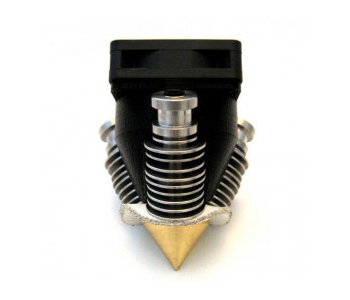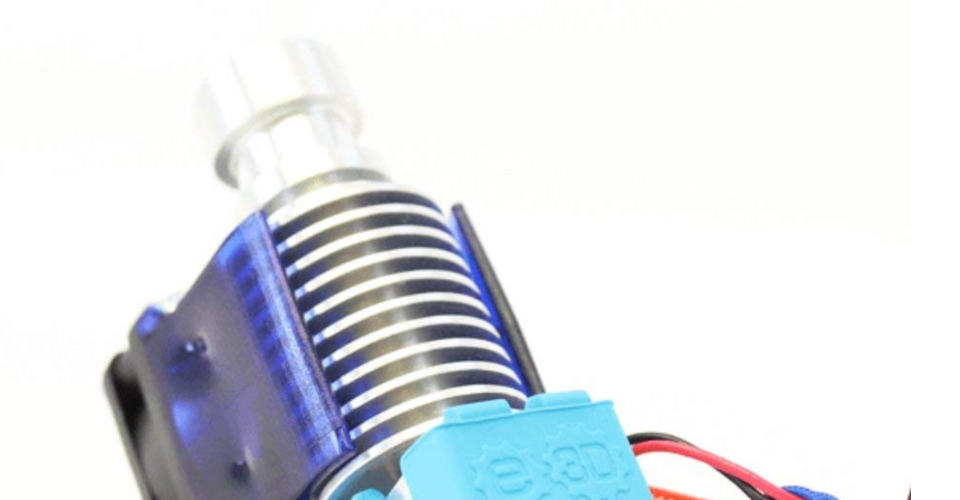3D Printing with an All-Metal Hot End: What’s the Big Deal?
Becoming a really good 3D printing professional takes a lot of practice and learning how the individual components of the printer work together to create a high-quality product. When you start moving on to creating more complex designs with specialized filaments, the stock components that came with your 3D printer when you bought it might no longer be up to the task. Among the 3D printing community, a popular and easy customization option is to use an all-metal hot end. How does an all-metal hot end differ from your stock hot end? What are its advantages and disadvantages?
What’s an all-metal hot end?

To understand what makes an all-metal hot end so special, we need to go back to the design of a standard hot end – the type that probably came with your 3D printer. All hot ends have a melting zone where the filament undergoes melting via heating. The high temperature of this zone needs to be insulated from the rest of the filament to avoid premature melting and poor extrusion. This critical role is played by a Polyether ether ketone (PEEK) insulator, located right above the melting zone.
Located right above the insulator block is a Polytetrafluoroethylene (PTFE) tubing. PTFE is a very low-friction, non-stick material that allows smooth passage of the filament material, even when retracting heated filament.
While a standard PEEK/PEI filament works well for most filaments, including the super-popular PLA and ABS, problems will start to come up if you use them for filaments that require very high printing temperatures. Good examples of these filaments include Nylon (240 °C) and Polycarbonate (260 °C). At above 240 °C, both PEEK and PTFE start to break down. This results in the degradation in their quality over time until they come to a point where they need to be replaced.
The most common method to remedy the problem of printing with high temperature using a PEEK/PEI hot end is to use an all-metal alternative. An all-metal hot end uses a thin strip of stainless steel as a heat break to separate the melting zone from the rest of the extruder. The heat break is then connected to a heat sink that undergoes active cooling, typically using a fan.
Take note that are different types of all-metal hot ends out in the market. Some models stick to their namesake by being created completely with metal. Other “all-metal” hot ends incorporate a PTFE tubing into the heat sink to provide a non-stick surface for filament extruding. However, such all-metal hot ends are designed such that the PTFE tubing is only exposed to ambient temperature to avoid heat degradation.
What are the benefits of using an all-metal hot end?
1. Printing at high temperatures
The main reason why you would want to switch to an all-metal hot end is so you can print at high temperatures without any problems. The metal components of an all-metal nozzle can be exposed to very high temperatures repeatedly for long periods without any heat degradation concerns.
2. PTFE liner no longer needs to be replaced
As a direct consequence of the absence of a PTFE liner that is exposed to high temperatures, you will no longer need to regularly replace your hot end’s PTFE liner. Depending on your level of use, printing at high temperatures using a standard PTFE hot end will severely discolor and degrade the PTFE liner within the space of a few months to a year.
While a replacement PTFE liner isn’t expensive, the work needed to dismantle your whole extruder set up to get to the plastic parts can be quite overwhelming. There are also a lot of things that can go wrong during the whole dismantling and installation process, and you could end up with a bigger problem than what you started with.
Are there drawbacks to using an all-metal hot end?
1. Poor retraction
The biggest drawback of switching to an all-metal hot end is the loss of the PTFE tubing. The PTFE surface provides a worry-free low-friction surface that can convey filament even at higher temperatures. This becomes more of a problem when you apply retraction settings that pull back a significant portion of hot filament towards the heat sink. The hotter and stickier filament will tend to adhere to the stainless-steel walls of an all-metal hot end.
A common piece of advice when working with an all-metal hot end is to minimize retraction. This is easy to do but is much harder to implement especially if you are printing a design with large gaps.
2. Jamming more likely to happen
Jamming is another consequence of the issues of all-metal hot ends with retraction. As hot filament enters the heat sink, it undergoes a drastic drop in temperature that will result in its partial solidification. This partially molten filament will take the shape of the stainless-steel tubing, effectively forming a “plug” that will jam the extruder. Minimizing retraction will make this problem less likely to happen. However, as mentioned above, minimal retraction might not even be an available option for some designs.
Tips on using an all-metal hot end
Although it seems that there are a lot of big issues that you will run into once you make the switch to an all-metal hot end, a lot of 3D printing professionals have managed to make it work with the right combination of innovative methods and good equipment.
1. Dial down the retraction settings
The biggest problem of using an all-metal hot end comes from the re-solidification of the molten filament when it gets pulled back towards the heat sink. The easiest way to eliminate this problem is to adjust printer settings to as little retraction as possible.
You can do this by starting at zero retraction and testing how the filament performs. If you encounter stringing problems, you can try increasing retraction by 0.05 mm increments until you get results you are satisfied with.
2. Use a good fan for the heat sink
The heat sink of an all-metal hot end serves to isolate the heat of the melting zone from the rest of the filament so that it does not undergo premature heating. To do this, the heat sink depends on the active cooling mechanism provided by a cooling fan. You want to get the sharpest temperature transition possible in the heat sink, so it’s best to use a high-powered fan at the highest setting. Otherwise, “heat creep” will lead to poor flow control and inconsistent print quality.
3. Apply some lubrication on the filament
This is more of a “last resort” if you are still not getting encountering jams in the extruder even at low retraction and high cooling. To lubricate your filament, just apply a very thin film of a mineral or vegetable oil (such as canola) the filament between the filament spool and the drive gear.
The most important thing to remember is not to overdo it – a little goes a long way. A paper towel dabbed with oil is the best way to apply the oil, and you probably won’t need to do it the whole time that you’re printing. Applying the oil to the filament will serve to coat the inner surface of the tubing in the hot end, which should provide enough lubrication for the whole printing process.
However, there are some caveats to this method that make it the last option for most 3D printing professionals. There have been arguments on whether applying a lubricant to the hot end will cause long-term problems to the hot end. The effects of the lubricant on layer adhesion also have not been determined with certainty. After all, layers stick to each other at the molecular level, so any impurities have the potential to compromise the integrity of layer-to-layer bonding.
Final thoughts
Using an all-metal hot end is just one of the many ways that you can expand your horizons in 3D printing. Making the shift to an all-metal hot end is essential if you want to print at higher temperatures, such as when using Nylon and Polycarbonate filaments. These filaments are some of the most challenging materials you can print with, so you’ll need to equip yourself with all the right tools.
That being said, an all-metal hot end isn’t some sort of magical solution to the problems of printing at high temperatures. It comes with a set of challenges that you’ll need to work around. It’s all part and parcel of leveling up your skills in 3D printing.





